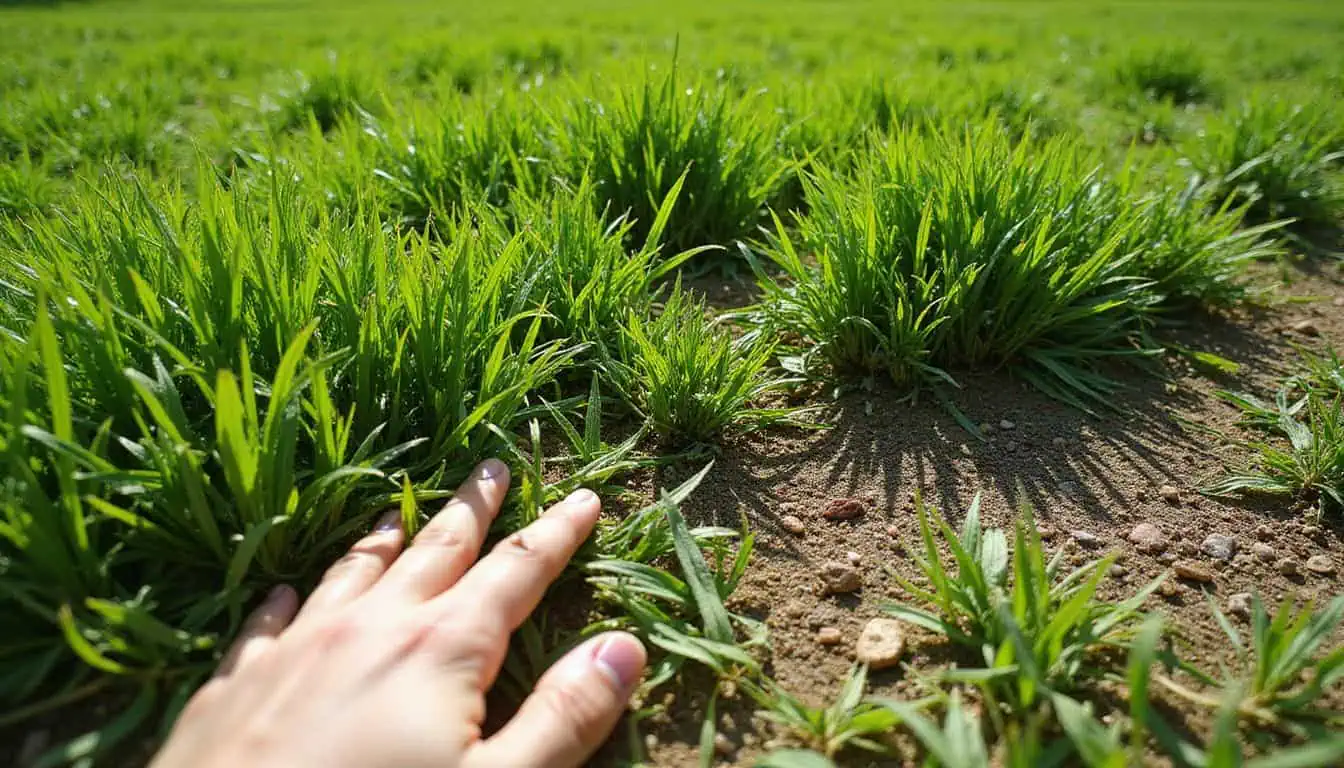Wondering why your lawn never quite looks like the lush green turf next door, even after hours of work? Well, keeping your grass trimmed isn’t just about looks; regular lawn mowing actually boosts healthy grass growth and helps keep weeds away.
In this post, you’ll find out exactly why mowing the lawn is important and discover 9 surprising ways it benefits you, your family, and even the environment. Read on to finally get that beautiful—and healthy—yard you’ve always wanted!
Key Takeaways
Regular mowing keeps grass healthy—removing weak blades and helping sturdy ones thrive at an ideal height of around 3 to 3.5 inches.
Neatly trimmed lawns lift property values by about 5 to 10%, giving your neighborhood a welcoming feel and showing you care.
Frequent mowing stops weeds from spreading; cutting them before they form seeds, while healthier grass naturally pushes weeds out.
Lawn maintenance reduces hiding places for pests like snakes and ticks, so your yard stays safer for kids, pets, and family time.
Grass clippings naturally feed your soil, returning roughly 1 to 2 pounds of free nitrogen per year for every 1,000 square feet.
Table of Contents
Promotes Healthy Grass Growth
You already know lawn care is important—now here’s how mowing keeps your grass healthy. Regular mowing strengthens your grass. Each trim lets the healthiest blades grow stronger while removing the weaker strands.
Think of your mower as a workout coach: it pushes your yard to become tougher against harsh weather and pesky insects.
Recently, I was checking out options to buy aftermarket mower belts and learned that cutting height really matters. Lawn experts say grass in yards should stay around 3 to 3.5 inches high.
In hotter weather, raise the mower deck to 4 inches to protect the grass. Plus, leaving small grass clippings after mowing helps your lawn too. These clippings break down fast, feeding the soil with natural nutrients.
A well-mowed lawn isn’t just about looks. It’s a living system that grows stronger with each proper cut.
This “free fertilizer” gives roots the energy to grow deeper and stronger. One important tip—never slice off more than a third of grass length at one time.
Enhances Lawn Aesthetics
A neatly trimmed lawn instantly boosts curb appeal, making your property stand out. Crisp lines between grass and garden beds show neighbors you take pride in your home. Studies indicate a good-looking lawn can even increase property values by around 5 to 10 percent.
Bright, healthy Kentucky bluegrass or perennial ryegrass sets the perfect stage for colorful flowers and shrubs. I notice my lawn always looks best right after mowing, especially if I stick closely to recommended cutting heights.
But a well-kept lawn does more than enhance appearances—it creates an impression of order and stability. Caitlin Flanagan once compared a tidy lawn’s effect to the message sent by a neatly shoveled driveway during winter.
Proper mowing helps prevent uneven growth, ensuring sunlight can evenly reach each blade. The result? A lush, uniform carpet of grass that’s comfortable and inviting beneath bare feet, ideal for backyard gatherings in summertime.
Homeowners throughout Alexandria and Arlington clearly value this benefit; more than 85 staff members at Kingstowne regularly care for lawns across various Virginia neighborhoods.
Prevents Weed Overgrowth
Keeping your lawn neatly trimmed does a lot more than just boost curb appeal—it also helps stop weeds from taking over. Your mower acts like a front-line soldier against pesky weeds.
Cutting grass to the proper height creates a thick, dense lawn that naturally crowds out intruders. There’s actually a bit of simple science here: healthy grass takes over space, water, and nutrients, leaving weeds hungry and struggling to survive.
Regular mowing also interrupts weeds’ life cycles by cutting them down before they form mature seeds. This stops new weeds from sprouting up later. Frequent trims encourage grass to grow deeper roots as well, helping your lawn soak up water and nutrients better and leaving weeds fewer resources to survive.
Many women say that trimming no more than one-third off the top of each grass blade forms a natural shield against stubborn invaders like crabgrass and dandelions, keeping chemicals out of the yard.
This natural method promotes a healthier yard for wildlife—plus, your wallet benefits from buying fewer lawn treatments.
Supports Ecosystem Balance

Regular mowing helps keep your lawn’s ecosystem balanced and healthy. Your grass acts like a mini-habitat, connecting your yard with the environment around your home. Alexandra Contosta, from UNH, highlights that these small ecosystems can impact global environmental health.
Proper mowing methods control invasive plant growth, giving native plants a better chance to flourish. Native plants, allowed room to grow, help improve soil quality by preventing nutrients from leaching away.
How often you mow matters, too. Choosing a “low mow” schedule—cutting every two weeks instead of every week—can deliver surprising benefits. Giving flowering plants extra time to bloom helps bees and other pollinating insects gather food.
Your yard then becomes a helpful part of the local wildlife cycle, yet it still appears tidy and maintained. Grass clippings, left as mulch, improve carbon storage by adding organic material back to the soil.
Next, let’s check out how regular mowing boosts safety and creates a comfortable outdoor space for your family’s activities.
Improves Safety and Accessibility
A neatly trimmed lawn helps protect your family and pets. Tall grass often hides sharp objects, harmful pests, or even small holes—which can all hurt kids playing outdoors. On June 8, 2023, Theodore R.
Johnson learned this firsthand, after his neighbor complimented his carefully maintained grass. Short turfgrass reduces hiding spots for snakes, ticks, and other pests—keeping your loved ones safe.
Neighborhoods with neatly kept yards tend to see fewer crimes. Criminals and vandals notice tidy lawns, and they move on, sensing residents who care and keep watch.
Mowing your lawn often creates a more usable outdoor space. Walking on short, neat grass feels easy and comfortable. Tall, tangled weeds make moving around difficult—especially for elderly family members or anyone with mobility issues.
Proper mowing also slows weed growth. This means fewer harsh chemicals and herbicides around the yard. Maintaining grasses like fescues helps create an attractive, practical outdoor space—particularly compared to artificial turf.
(For more information, check out this helpful article: compared to artificial grass.) Keeping your grass trimmed also boosts soil health—which benefits your entire yard’s ecosystem.
Reduces Pest Infestation Risks
Regular mowing keeps pests away from your yard. Short grass discourages insects and rodents from making your lawn home—keeping it safer for kids and pets. I saw this clearly last summer, after switching from monthly trimming to weekly mowing.
The tick count dropped significantly, and fewer mosquitoes hovered around our patio.
Consistent mowing creates thick, healthy turf that gives pests fewer places to hide. This dense grass makes it tough for harmful bugs and poisonous weeds to take root. Maintaining the proper grass length helps block pests like fleas and ticks from settling down in your lawn.
Your family and pets can enjoy the outdoors in safety, without harsh chemicals.
Mulching, a simple by-product of mowing, breaks down fallen leaves and other debris. This process removes the damp, shady conditions where pests love to breed—giving you one less worry.
Helps Maintain Soil Health
Mowing your lawn offers more than a neat appearance. Every pass of your mower leaves behind small grass clippings, boosting the soil with important nutrients. These tiny pieces break down easily, returning about 1 to 2 pounds of nitrogen per 1,000 square feet each year.
This natural breakdown acts like compost—feeding your soil and making your grass strong and healthy. As these clippings decompose, they help improve your soil’s structure, letting water seep deeper and more effectively.
When you cut frequently, grass roots become tougher and more resilient. Stronger roots grip the soil tightly, protecting your yard from erosion during heavy rain. This keeps your topsoil stable and prevents water from quickly washing away.
The grass pieces left behind also add carbon to the soil, helping fight climate change by storing carbon in your yard, rather than releasing it into the atmosphere. Smart mowing habits like these work naturally—helping your grass grow lush, your soil become richer, and tiny helpful soil organisms thrive.
Encourages Biodiversity with Proper Mowing Practices
Healthy soil sets the foundation for a vibrant lawn ecosystem—but your lawn care choices directly affect the wildlife your yard attracts. Research reveals that reducing mowing frequency increases urban biodiversity.
Less mowing means more plant diversity and pollinators. That outdated notion that shorter grass is always best simply isn’t accurate. Creating areas called “no mow zones” in parts of your yard gives butterflies safe spots to thrive, while also saving you weekend chore time.
Your mower doesn’t have to run every week to keep your lawn looking great.
The best gardens have room for both neatness and nature.
Many women worry that longer grass might mean more ticks, but science shows that’s not the case. Researchers found no connection between grass length and tick populations. Ticks latch onto animals like deer, not longer grass blades.
The actual issue is excessive mowing, which kills beneficial insects and plants, opening space for pests. A thin layer of fallen leaves and slightly taller grass help seeds grow and shelter valuable insects.
These beneficial insects break down dead plants, returning nutrients into the soil. With rising temperatures these days, smart mowing practices become even more vital for maintaining lively, thriving yards.
How Will Lawn Care Practices Evolve in 2025?
Lawn care is quickly shifting as we approach 2025, with fresh trends making yard tasks easier and kinder to our environment.
- Electric lawnmowers will become standard equipment, capturing more than 55% of mower sales. These quiet devices trim grass without the noise or exhaust from gas-powered types.
- Smart lawn gadgets will cut down your weekly chores. Robotic lawnmowers will trim grass while you relax with family or spend time watering the flowers.
- Mulching grass clippings will gain popularity, with about 71% of homeowners adopting the practice at least once per season. Mulched clippings return nutrients to the soil and naturally reduce weeds.
- Sustainable lawn habits will move into the mainstream, becoming regular practice instead of a special preference. Care methods will cooperate with nature rather than work against it.
- Smaller yet practical lawns will replace huge grassy areas—63% of homeowners in the U.S. now prefer manageable outdoor living spaces to sprawling yards.
- Composting will steadily rise, and 60% of property owners will recycle yard waste, like grass clippings and fallen leaves, into soil-rich compost for gardens.
- Rising temperatures will shift grass type preferences in many areas. Varieties that handle drought well will grow more common and popular across the nation.
- Lawn maintenance apps will recommend mowing schedules based on the local weather, current soil quality, and grass growth patterns.
- Organic weed-control techniques will increasingly substitute for chemical weed killers, especially as homeowners better understand the advantages of decomposed natural materials.
- Significant research funding—such as the $260 million the University of New Hampshire received in 2021—will support developing new grass seeds. These improved seeds will naturally resist pests and require less watering.
People Also Ask
How does mowing help with weed control in my lawn?
Frequent mowing prevents weeds from growing tall enough to produce seeds. This reduces the chance of new sprouts popping up later. By mowing regularly, you help grass crowd out unwanted plants, keeping weeds under control.
Does lawn-care like mowing help with warming temperatures?
Absolutely! Properly cared-for grass stays cooler than bare dirt or paved areas. Grass cools the surrounding air naturally through transpiration—a process where water evaporates from grass leaves—helping your lawn feel cooler even on warm days.
Should I leave leaf litter on my lawn after mowing?
Small bits of finely chopped leaf litter can be healthy for your lawn, breaking down and delivering nutrients to the soil. But a thick layer of leaves can block air and sunlight, causing damage to grass below. It’s better to mulch fallen leaves into tiny pieces during mowing, helping them decay quicker and feed the grass naturally.
How does mowing affect the nutrition of my lawn?
Cutting grass to the correct height lets it grow deeper roots, better able to reach nutrients from deeper soil layers. Leaving short clippings from mowing on your lawn provides extra nutrients by quickly breaking down into organic matter. These clippings act like a free, natural fertilizer, adding beneficial nutrients back into the soil.
References
https://www.newsouthtractor.com/blog/9-benefits-of-mowing-your-lawn–21955
https://www.turfpridelawncare.com/blog/reasons-why-lawn-care-vital-beautiful-lawn
https://petersonslandscape.com/regular-lawn-mowing-the-importance-for-a-lush-and-healthy-lawn/
https://naturesturf.com/top-5-benefits-of-mowing-your-grass/
https://www.johnsonsfarmsfl.com/how-environmental-mowing-contributes-to-healthy-ecosystems (2024-12-30)
https://acsess.onlinelibrary.wiley.com/doi/10.1002/csc2.21376
https://acsess.onlinelibrary.wiley.com/doi/10.1002/csc2.21383
https://www.sciencedaily.com/releases/2019/12/191219074744.htm
https://ocnjdaily.com/news/2025/feb/07/lawn-mowing-trends-in-2025-and-household-tips/
